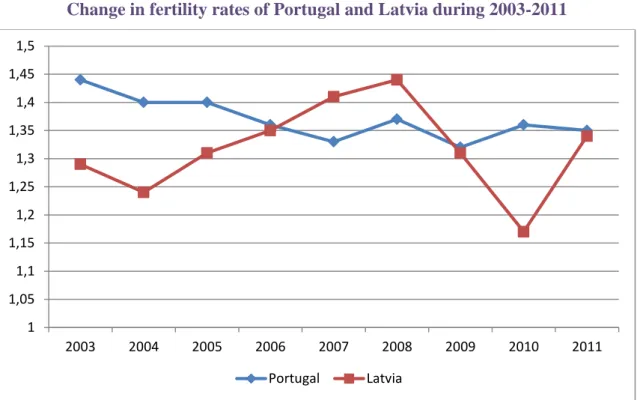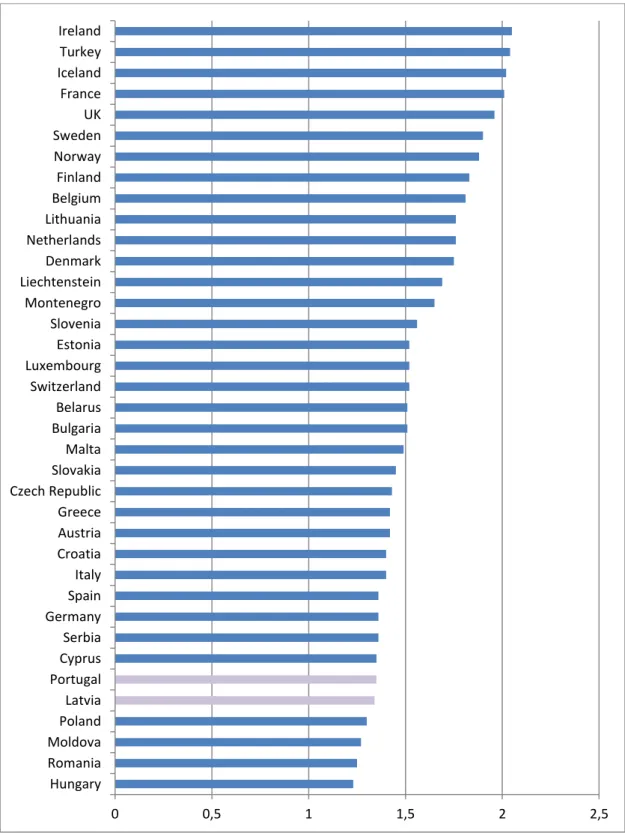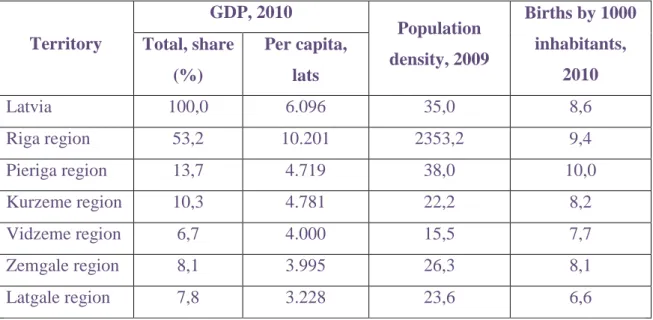УДК
THE ECONOMIC CRISIS – SOME CONSEQUENCES FOR FERTILITY BEHAVIOUR: THE CASES OF PORTUGAL AND LATVIA
Dr.sc.soc. Maria Johanna Schouten, professor University of Beira Interior, Covilha, Portugal
Dr.oec. Vera Boronenko, lead researcher University of Daugavpils, Daugavpils, Latvia
Several European countries are, or have recently been, confronted with a series of crises which mutually affect each other. In this paper the economic crisis but especially the demographic crisis, caused by a sharp decline in birth rate, will be discussed. This tendency in fertility behaviour has been going on for some decades, in part because of the high requirements of children as to economic costs, time and energy of the parents, in particular the mothers. The decrease of births has been aggravated by deteriorating economic conditions. The authors will focus the interrelation between recent economic and demographic developments with regard to two countries, Portugal and Latvia, and with special attention to underprivileged, peripheral, regions. Relevant demographic data will be presented, and in discussing the fertility behaviour, economic conditions and also cultural factors will be considered, in particular the role attributed to women as mothers, and the value attached to children in the family.
Key words: economic crisis, fertility behaviour, demographic trends, motherhood, Portugal, Latvia.
Introduction: research topicality, background and methodology
Europe is confronted with a series of crises which mutually affect each other. In this paper we will discuss the economic crisis but especially the demographic crisis, which has been aggravated by the economic situation. We will focus the economy and demography in two countries, Portugal and Latvia, with special attention to underprivileged, peripheral, regions.
Many European countries have been suffering a population decline over the last few decades. The general trend is the growth of the number of senior citizens (over 65 years of age) and a decreasing proportion of young people. This so-called demographic ageing will have profound effects on society in the 21st century, and some of these effects already start to be noticeable.
The ageing of the population means that people live longer thanks to the improvement of medical services and general living conditions. But the situation might
be problematic if there are fewer young people who can take care of the elderly, in the economic and social aspects. And that is exactly the case: in Europe, the number of children born is decreasing. This is a biological fact with social causes, since it is the social-economic context which discourages people from having (more) children. In sociological and demographic terms, we speak of a change in fertility behaviour among the population (Schmid 1989, Лабзин 2003, Овчарова 2010, Boronenko, Schouten 2010, Burkimsher 2013), and it is worthwhile, in this paper, to explore this phenomenon as well as the reasons behind it.
There are manifold reasons for having or not having children, and among these the implications or perceived implications which motherhood has on women’s life will be highlighted, with special attention to the resources needed for the having and raising of children. These resources are in particular the economic means, the time available for certain tasks and activities, and the physical strength. On a more macro-level, consideration should be given to economic conditions and also to cultural factors, in particular the role attributed to women as mothers, and the value attached to children.
So, the main research problem, defined by the authors, is that in Portugal and Latvia (as in most European countries) fertility behaviour of the population was changing during the current economic crisis, and this change dramatizes the consequences of economic crisis. The aim of the article is to stress and to explain the consequences of the economic crises for fertility behaviour in Portugal and Latvia as two geographic poles of Europe. To achieve this goal, the comparative case study method will be used, with analysis of statistical trends and secondary analysis of the data of current researches, as well as a logical analysis for explaining the reasons of the change of fertility behaviour under the conditions of economic crisis. The research findings of social scientists from both Western and Eastern Europe will be used in this article.
Economic and fertility trends of Portugal and Latvia
Portugal is a small country in the southwestern corner of Europe, and Latvia a small country in the northeastern corner of the EU. On the 31st of December of 2012, the population of Portugal numbered 10,487,289 (INE – Instituto Nacional de Estatística), which meant a decrease over 2012 of 55,000 inhabitants (0.01%). In its turn, the population of Latvia on the 1st of January of 2013 numbered 2,023,825, and it
decreased by 20,988 inhabitants over 2012 (also 0.01%) (LR CSB 2013a). However, Eurostat gives an even smaller number of Latvian inhabitants on the 1st January of 2013 - 2.017.526 - with decreasing of 24.237 inhabitants (also 0.01%) (Eurostat 2013a).
One of the reasons for the decrease of the population in both countries is a low fertility rate. Another significant one is emigration, but this is not the topic of this research, though it is closely interconnected with the fall in births, because emigrants usually are young people in their reproductive years.
Figure 1 Change in fertility rates of Portugal and Latvia during 2003-2011
Source: Eurostat 2013b.
As the data of Figure 1 show, the fertility behaviour has been changing in periods of economic difficulties, especially in Latvia, where the fertility rate decreased after the economic crisis of 2008-2009. The trend in Portugal is more stable, maintaining a decreasing tendency in comparison with the early 2000s. We will briefly consider the economic developments in both countries.
Figure 2 Economic trends in Portugal and Latvia: final consumption aggregates, index
(2005=100), 2005-2014 (forecast) 1 1,05 1,1 1,15 1,2 1,25 1,3 1,35 1,4 1,45 1,5 2003 2004 2005 2006 2007 2008 2009 2010 2011 Portugal Latvia
Source: Eurostat 2013c.
The data of Figure 2 suggest that the economic trend of Portugal was more stable than in Latvia, and the trends of fertility rates of both countries in general accord with their economic trends.
Demographers have developed several projections for the decades to come. But a recovery of the number of inhabitants in the natural way (thus, excluding immigration), is not to be foreseen, since a decrease in the birth rate has effects for the number of births in the next generation. It has to be remarked that none of European and neighbouring countries shown in Figure 2 has achieved the rate of 2.1, which is usually considered as being the average number of children women should bear to guarantee the continuation of the population in the same numbers The fertility rates of 2011 of the countries under consideration - 1.35 in Portugal and 1.34 in Latvia (Eurostat 2013b) - are among the very lowest of European and neighbouring countries and with a tendency of further decrease. 0 20 40 60 80 100 120 140 2005 2006 2007 2008 2009 2010 2011 2012 2013 2014 Portugal Latvia
Figure 3 Comparison of fertility rates in EU, EEA and some neighbouring countries, 2011
Source: Eurostat 2013b. 0 0,5 1 1,5 2 2,5 Hungary Romania Moldova Poland Latvia Portugal Cyprus Serbia Germany Spain Italy Croatia Austria Greece Czech Republic Slovakia Malta Bulgaria Belarus Switzerland Luxembourg Estonia Slovenia Montenegro Liechtenstein Denmark Netherlands Lithuania Belgium Finland Norway Sweden UK France Iceland Turkey Ireland
Both Portugal and Latvia face, in the social-demographic aspect, another problem, which is the uneven distribution of the population and of the quantitative indicators of its fertility behaviour over their territories. The population is concentrated (and tends increasingly to concentrate) in the coastal strip in Portugal and in the capital in Latvia, leaving the interior with less population and less potential of economic development. Moreover, there is also a lower fertility rate in the peripheral regions of our countries, which is troubling the social and economic development of regions and causing their marginalization.
Table 1 GDP per capita, population density and fertility rate in Latvian regions
Territory GDP, 2010 Population density, 2009 Births by 1000 inhabitants, 2010 Total, share (%) Per capita, lats Latvia 100,0 6.096 35,0 8,6 Riga region 53,2 10.201 2353,2 9,4 Pieriga region 13,7 4.719 38,0 10,0 Kurzeme region 10,3 4.781 22,2 8,2 Vidzeme region 6,7 4.000 15,5 7,7 Zemgale region 8,1 3.995 26,3 8,1 Latgale region 7,8 3.228 23,6 6,6 Source: LR CSB 2013b, 2013c, VRAA 2010.
As the data of Table 1 show, there are big disproportions in economic activity and fertility behaviour in Latvian regions. Latgale region – the place of location of the Daugavpils University – is characterized by lower economic activity as well as a low birth rate.
For Portugal, we may compare the coastal regions of Lisbon and Porto with the interior regions of Beira Interior (north and south), in the following table:
Table 2
Demographic and Economic data for four regions in Portugal
Territory Births by 1000 inhabitants, 2012 General fertility rate,1 2012 GDP per capita in euro, 2010 Population density, 2011 North Beira Interior 5.8 29.,1 11,197 25.5 South Beira Interior 7.0 34.1 13,983 19.9 Greater Lisbon 10.5 44.9 27,074 1485-.2 Greater Porto 8.4 34.5 16,223 1577.5 Portugal 8.5 36.3 16,970 114.3
Source: INE – Instituto Nacional de Estatística 2013.
Beira Interior – the place of location of the University of Beira Interior - is characterized by low population density; many of the inhabitants are senior citizens and the number of children born is lower from year to year. It is significant that in the last ten years half of the elementary schools in the region have had to close down, for lack of pupils2. And the future is bleak: The recent study Demografia economicamente sustentável. Reverter o declínio em áreas periféricas («Economically sustainable demography. Turning back the decline in peripheral regions»), carried out by Portuguese researchers, including of the University of Beira Interior, predicts that if no adequate measures are taken, there will be zones in this region with just 25% of the present population and even the urban areas will have decreased considerably in population (Fidalgo 2013).
Discussion: what are the reasons for the low fertiity rate in Portugal and Latvia?
The actual research question addresses the reasons behind the low fertility level in Portugal and Latvia, and its relation with economic ups and downs.
1
The number of births in a year divided by the number of women aged 15–44, times 1000. 2
The number of schools went from 232 to 105. According to Portuguese law, for a school to be allowed to function, it should have a minimum of 20 pupils, aged 6 – 10.
Portugal and Latvia are hard-hit by the economic crisis in Europe and many austerity measures are being taken, which lower the incomes of the families, and affect tax benefits and social equipments for families with children.
At the same time it is true that before the economic crisis – for example, during the so called “well-being years” (2006-2007) in Latvia – fertility rate was higher (see Figure 1), but far from replacement rate. Moreover, as appears from the data of Figures 1 and 2, the economic trend in Portugal during the last years was more stable (in this case, going downwards) than in Latvia, but current fertility rates in Portugal and Latvia have almost the same low level.
So, the fundamental problem of fertility behaviour in the countries under consideration (as well as in all European and neighbouring countries) is that economic crisis can cause short-term negative quantitative change in fertility rates, but economic conditions are not on their own able to change long-term fertility behaviour of the population in our countries. This idea can be illustrated by one example of Portugal and Latvia: Portugal had a fertility rate of 2.1 in 1980 and 2.8 in 1970 (INE – Instituto Nacional de Estatística), but Latvia – 2.21 in 1987 (LR CSB 2011), before structural qualitative change of their economic, social and political system, before transition from totalitarian political regime to the market economy. None of countries shown in Figure 3 nowadays have such a high fertility rate, which is close to Portugal in 1980, Portugal in 1970 and Latvia in 1987 had a significantly higher birth-rate than the replacement rate of 2.1. It is obvious that the periods of these higher birth rates - in totalitarian Portugal and Latvia - were not at all periods with better economic conditions. Of course, in the explanation of the falling birth rate-. the widespread introduction of modern means of birth control should not be ignored But the decision to use or not use these depends on the people in question, in their broader social-cultural context.
The authors suppose that the central fundamental determinant in the phenomenon of low fertility in Portugal and Latvia (and in Europe as a whole) is the image and the roles attributed to mothers, fathers and children, i.e. the social and culturally-imposed requirements of motherhood in the present-day conditions of market economy.
World history over the centuries shows us that women have always worked: in agriculture, in trade, the manufacturing of artefacts and textile fabrics, and/or assisting their husbands or relatives in their respective jobs. This work was combined with household chores and caring work, in almost all societies the realm of women. In this
very busy life, women’s work was often not formal and recognized as such, and it was organized in function of the situation of the moment.
A formalization of women’s work took place in Europe and northern America (the so-called “western world”) in the age of the industrial revolution when work in the factories, under a strictly scheduled regime, meant a separation in time and space between home and work. At the same time (the 19th century) new ideas and practices were introduced about the management of households, and the education of children. Stricter hygiene and a more intense supervision of children became the norm. This trend has continued until today, with the difference that nowadays women have obtained access to (almost) all studies and professions and have a broader participation in the formal labour market.
Gender inequality may thus have lessened, but in reality is still present all over the world, albeit in varying degrees (Hausmann et al. 2012). Crucial is the persistence of the division of roles in the domestic sphere, in which women are still bearing the responsibility for the domestic chores, including childcare. And the care and education of children according to today’s norms requires much dedication.
Various authors emphasize how, in recent decades, material resources, time and emotions which parents invest into their children have increased considerably (Gershuny and Jones 1987). Ulrich Beck notices a prevailing feeling in the western world that a child provides joy and gives variation to life, in an era of disenchantment and individualization. In this sense, having children is a “private type of re-enchantment”, which is a reason for the “excessive affection for children” (Beck 1992, pp. 118-119; see also Roussel 1989; Crompton and Lyonette 2007).
However, the wish to give a future child an optimal attention and plenty of material resources imbues young people with doubts and apprehension: are they ready for a child, will their financial situation and the life they lead allow them to give to a child what is considered necessary and its due right?
These dilemmas are particularly strong in the case of mothers (Schouten 2011, pp. 53-70; Schouten and Lourenço 2012). The combination of work and private life is for many families and especially women a daily recurring affliction. In some European societies most women try to combine a full-time job with motherhood, in many others they work fewer hours or withdraw temporarily from the labour market. On the other hand, there are women who implicitly or explicitly opt for a life without children, convinced that they will not be able to give a child its due share of resources and
attention. For quite a few highly-instructed women, remaining childless seems the only way to pursue their careers (Boronenko and Schouten 2010).
Leaving aside biological reasons, we should recall that in today’s societies, the wish for parenthood is sometimes impossible to fulfill or has to be postponed for economic and social reasons, as well as the individual biography. The combination, both in Portugal and in Latvia, of a strong wish for children and the difficulties and sacrifices required for the bringing up of children has led to the typical pattern of the one-child-family.
Conclusions
Both Portugal and Latvia have suffered from economic crisis during recent years and their fertility rates are among the lowest in Europe; these countries have also the similar historical experience of totalitarian political regimes (although of different character), and had significantly higher fertility rates some decades ago.
The more marginal and underprivileged regions in both countries are also the regions with a lower birth rate;
Economic crisis has a short-term negative impact on fertility rate in the countries under consideration, but the long-term pattern of fertility behaviour both in Portugal and Latvia is determined by social and culturally-imposed requirements of motherhood in the conditions of market economy.
A greater sharing of responsibilities between fathers and mothers would have a beneficial effect both on numbers of birth and on the equality of opportunities between men and women.
References
Beck U. (1992) Risk Society: Towards a New Modernity. London: Sage.
Boronenko V., Schouten M. (2010) Career Paths of Young Mothers in Latvia and Portugal. Social Science Buleltin, Vol. 1(10), pp. 34-49. Available:
Burkimsher M. (2013) New Fertility Behaviour in Eastern Europe: How it Has Emerged and Future Prospects (Case studies of Bulgaria, Hungary and Georgia).
Available:http://www.unige.ch/ses/demog/Publicationsetrapports/Memoiresmaster/Marionfinal.pdf
Crompton R., Lyonette C. (2007) Família, género e articulação entre trabalho e vida privada: comparação dos casos britânico e português. In: Wall K., Lígia A. (Eds.). Família e género em Portugal e na Europa. Lisboa: Imprensa de Ciências Socialis, pp. 93-128.
Eurostat. (2013a) Population on 1 January. Statistics Database “Population and Social Conditions”. Available: http://epp.eurostat.ec.europa.eu/portal/page/portal/statistics/search_database
Eurostat. (2013b) Fertility Indicators: Total Fertility Rate. Statistics Database “Population and Social Conditions”. Available: http://epp.eurostat.ec.europa.eu/portal/page/portal/statistics/search_database Eurostat. (2013c) Final Consumption Aggregates – Volumes: Index, 2005=100. Statistics Database “Economy and Finances”. Available:
http://epp.eurostat.ec.europa.eu/portal/page/portal/statistics/search_database
Fidalgo A. (2013) Discurso na tomada de posse como Reitor. Covilhã: Universidade da Beira Interior.
Gershuny J., Jones, Sally (1987) The Changing Work/Leisure Balance in Britain, 1961-1984. Horne J., Jary D., Tomlinson A. (Eds.), Sport, Leisure and Social Relations. London: The Sociological Review/ Routledge, pp. 9-50.
Hausmann R., Tyson L.D., Zahidi S. (2012) The Global Gender Gap Report 2012. Geneva: World Economic Forum.
INE – Instituto Nacional de Estatística. (2013) Dados Estatísticos. Lisbon. Available: http://www.ine.pt/xportal/.
LR CSB. (2011) Demogrāfiskās statistikas galvenie rādītāji 2010. gadā. Informatīvs apskats. Available:
http://www.csb.gov.lv/sites/default/files/publikacijas/zz_nr_12_demografiskas_statistikas_galvenie_radit aji_2010_11_00_lv.pdf
LR CSB. (2013a) Table ISG02: Resident Population at the Beginning of the Year. Statistics Database. Available:
http://data.csb.gov.lv/DATABASEEN/Iedz/Population%20Number%20and%20Change/Data%20recalcul ated%20according%20to%20the%20results%20of%20the%20PHC%202011/Data%20recalculated%20ac cording%20to%20the%20results%20of%20the%20PHC%202011.asp
LR CSB. (2013b) Table IKG021: Gross Domestic Product by Statistical Region, City and District (NACE rev. 2). Statistics Database. Available:
http://data.csb.gov.lv/DATABASEEN/ekfin/Annual%20statistical%20data/02.%20Gross%20domestic%2 0product/02.%20Gross%20domestic%20product.asp
LR CSB. (2013c) Table IS01A: Administrative division and population density at the Beginning of the Year, 1995-2009. Statistics Database. Available:
http://data.csb.gov.lv/DATABASEEN/Iedzsoc/Annual%20statistical%20data/04.%20Population%20F%2 0Archive/04.%20Population%20F%20Archive.asp
Roussel L. (1989) La Famille Incertaine. Paris: Odile Jacob.
Schmid J. (1989) The Background of Fertility Behaviour in Europe - New Social and Psychological Aspects. Cliquet R.L., Dooghe G., Jong-Gierveld J., Poppel F. (Eds.) Population and Family in the Low Countries VI. (Netherlands Interdisciplinary Demographic Institute (N.I.D.I.) and The Population and Family Study Centre (C.B.G.S.), Vol. 18, The Hague/Brüssel, pp. 1-16.
Schouten M.J. (2011) Uma sociologia do género. Ribeirão: Húmus.
Schouten, M.J. ; Lourenço, Lia (2012) "La maternité et la paternité et l'allocation du temps au Portugal", in: Yvonne Knibiehler,c.s. (eds.) La maternité à l'épreuve du genre. Métamorphoses et permanences de la maternité dans l'aire méditerranéenne, pp 205-216. Rennes: Presses de l’Ecole des Hautes Etudes en Santé Publique (EHESP).
VRAA. (2011) Reģionu attīstība Latvijā 2010. Available: http://www.vraa.gov.lv/uploads/1-2_lv.pdf
Лабзин А.В. (2003) Особенности репродуктивного поведения населения в реформируемой России: На примере Самарской области. Научная библиотека диссертаций и авторефератов disserCat http://www.dissercat.com/content/osobennosti-reproduktivnogo-povedeniya-naseleniya-v-reformiruemoi-rossii-na-primere-samarsko#ixzz2e19YTWHm Овчарова Л.Н. (отв.ред.) (2010) Детерминанты репродуктивного поведения населения и факторы семейного неблагополучия : результаты панельных исследований. Серия «Научные доклады: независимый экономический анализ», № 211. Москва: Московский общественный научный фонд; Независимый институт социальной политики.



